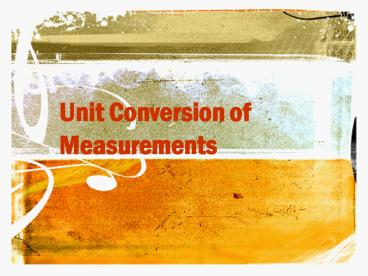Unit Conversion of Measurements - PowerPoint PPT Presentation
1 / 21
Title:
Unit Conversion of Measurements
Description:
Unit Conversion of Measurements Derived Unit A derived unit is a combination of the base units such as area (_m2_), volume, pressure, weight, force, and speed. – PowerPoint PPT presentation
Number of Views:175
Avg rating:3.0/5.0
Title: Unit Conversion of Measurements
1
Unit Conversion of Measurements
2
Derived Unit
- A derived unit is a combination of the base
units such as area (_m2_), volume, pressure,
weight, force, and speed.
3
Dimensional Analysis
- Sometimes the unit in which a quantity was
measured must be converted to a different unit so
it can be used in mathematical operations. - Suppose you have half a pizza and you want to
know how many slices you have. Pizza and slices
cannot be compared because they are different
units. To compare them, you need a conversion
factor. If a pizza has 8 slices, then 1 pizza 8
slices. This can be rewritten in the following
ways.
4
Dimensional Analysis
- If a pizza has 8 slices, then 1 pizza 8 slices.
This can be rewritten in the following ways.
- These are conversion factors. Notice that both
fractions are equal to 1. This means that if you
multiply them by another value, the value will
not change.
5
Dimensional Analysis
- You can use a conversion factor to convert the
amount of pizza into the number of slices. There
are four slices in half a pizza.
- Notice that the conversion factor was chosen so
that the new unit, slices, appears in the answer
and the original unit, pizza, cancels.
6
Simple Conversions
- How many meters are in 54 cm?
7
Determine the possible conversion factors
- The two units in this problem are m and cm. We
know that 1 m 100 cm. So,
8
Decide which conversion factor will give the
desired unit for the answer
- The answer needs to be in m. To get m we need to
use the conversion factor that has m in the
numerator and divides by cm (to cancel cm in the
original value).
9
Multiply the original value by the conversion
factor.
10
A roll of copper wire contains 15 m of wire.
What is the length of the wire incentimeters?
- possible conversion factors
- 1 m/ 100 cm or 100cm/ 1m
- 2. conversion factor used
- 100 cm / 1m
- 3. multiply original value
- 15 m x 100cm/ 1m 1 500 cm
11
Practice Lets convert the following
- 1. 550 mm ____.550______m
- 3.5 s ___3500_________ ms
- 1.6 kg _____1600_______g
- 2500 mg __.002500_______kg
12
(No Transcript)
13
Density and Specific Gravity
Would the density of a person by the same on the
surface of the earth and on the surface of the
moon?
14
- Density the amount of matter in an object per
unit volume - As the temperature of a material increases, the
density tends to decrease. - In the lab, the density of an irregularly shaped
object is found by water displacement
15
Density
- D m/v
- m mass (in grams)
- V volume (in cm3, ml or if a gas L)
- D density (g/cm3 , solid,
- g/ml liquid,
- g/L, gas)
- A student finds a shiny piece of metal she thinks
is aluminum. In the lab, she determines that the
metal has a volume of 245 cm3 and a mass of 612
g. Is the metal aluminum?
16
Solving the Problem by Density
d 612g/245 cm3 d 2.5 g/cm3
- D m/v
Density of Al 2.70 g/cm3 Density of the metal
2.50g/cm3
m
d
v
NO the metal is not Aluminum
17
PROBLEM
- A plastic ball with a volume of 19.7 cm3 has a
mass of 15.8 g. Would the ball float or sink in
a container of gasoline? (density of gas
0.66-0.69g/cm3) - A piece of iron has a mass of 2.25 g. What is its
volume?
18
Specific Gravity
- Specific gravity a ratio of the density of a
substance to the density of another substance
(usually water) at the same temperature - Density of water at 4ºC 1.0g/cm3
- Gravity density of substance (Specific
g/cm3) - density of water
(g/cm3)
19
Specific Gravity
- Specific gravity has no units b/c they cancel
out - At 4ºC what can you say about the density of an
object and its specific gravity? - Specific gravity is measured using a hydrometer
20
Three Temperature Scales
- Fahrenheit
- Celsius
- Kelvin
- Based on the freezing boiling point of alcohol
- Based on the freezing boiling point of water
- Based on absolute zero (temperature at which
there is no molecular motion
21
Temperature Conversions
- K C 273
- C K - 273
Example A gas has a temp. of 90 C. What is
the Kelvin temperature?
Temperature scale Boiling point of water Freezing point of water Absolute zero
Fahrenheit 212 32 - 459
Celsius 100 0 - 273
Kelvin 373 273 0































